Kategorie: Allgemein
Militaria Börse Lübeck II /2019
Tag Leute, wie schon im MFF beschrieben hier nochmal im Blog erläutert.
Objektiv beleuchtet war die zweite Börse in Lübeck in den Räumen des Auktionshauses HanseArt kein Erfolg….wobei man den Erfolg immer unterschiedlich messen sollte. Also was war passiert…… Vorangegangen war ja die Börse im März 2019 als Pilot oder Versuchsobjekt, ob solch eine Veranstaltung überhaupt die Resonanz findet die man sich wünscht. Fazit der ersten Börse war sehr positiv: 20 Aussteller / Händler / Sammler hatte sich gemeldet und Tische gebucht. Über 100 Sammler aus ganz Europa kamen vorbei und es wurde wirklich viel gehandelt und gefachsimpelt. Aus diesem Grunde wurde überhaupt erst über eine weitere Veranstaltung in diesem Jahr nachgedacht. Bei der Planung wurden dann Dinge wie Dorfmark, Sammlertreffen DGO und andere Börsen betrachtetet um nicht in eine Konkurrenzveranstaltung hinein zu planen. Der Termin 20. Oktober schien auch mit den Terminen des Auktionshauses keine Überschneidungen zu haben. Erst später wurde mir zugetragen, dass es parallel doch noch die Börse in Berlin geben sollte. War nun nicht mehr zu ändern….. Wie auch immer stellte sich heraus das es „nur 15“ Anmeldungen von Händlertischen gab und am Börsentag 2 Händler nicht erschienen sind und 3 Händler sich eine Woche vor der Börse abmeldeten. Nun gut, das ist ärgerlich…. vor allen Dingen weil man Ausstellertische von einem Eventausstatter anmieten muss. Also ging es am Börsentag schon nicht so gut los, aber trotzdem waren alle hoch motiviert. Leider kamen dann nur 30-40 Sammler vorbei, was für die Verkäufer dann auch nicht so gut war. Einiges wechselte den Besitzer aber unterm Strich blieb es doch stark unter den Erwartungen. Gegen 12:00 Uhr wurde dann abgebaut. Gegen 14:00 Uhr waren wir dann final fertig und das Auktionshaus war wieder in dem Zustand wie es für den Tagesbetrieb sein sollte. Einige Sammler fragten mich (und auch in den Foren) warum man denn so einen hohen Eintritt (10,- Euro – mit DGO Ausweis 5,- Euro) zahlen musste. Dazu kurz erklärt was es an Kosten so gibt. Man muss Personal bezahlen, Verpflegung, Tische und Stühle anmieten und eigentlich auch Miete für die Räumlichkeiten entrichten. Das alles zusammen soll / muss der Eintritt abdecken. Bei der März Börse war man noch mit 400,- Euro Minus in der Kasse stehen geblieben. Diesmal kam man wenigstens ins Plus, da die Miete für den Tag im Auktionshaus nicht berechnet wurde. Für mich persönlich war es dann doch sehr positiv, dass man die alten Haudegen und Sammlerfreunde traf und bei einer Tasse Kaffee mal etwas plaudern konnte. Die Fragen die einen nun beschäftigen: War die Werbung nicht weit genug gestreut? Ist der Bedarf in Norddeutschland für Börsen nicht da? War der Termin nicht gut gewählt? Sollte man es im Frühjahr 2020 noch einmal versuchen? Mit diesen Fragen Ende ich hier vorerst und bedanke mich bei allen Händlern und Sammlern die dort waren und „die Fahne“ hochgehalten haben.
Gruß Sascha
Expensive Cardboard ;-)
Happy new year to you all and may all your collector dreams come true 😉
After the dust of Kassel Fair settled down it is time to study again in our hobby.
Between X-Mas and new year I had some time to try out the You Tube possibilities. That way, I will try to make it more interesting for collectors and also for young collectors to come into our hobby. But I am just starting and there are a lot of things to think about. So if you like check that out and leave a feedback it would be very helpful. The first videos are in German language but I am working on English versions….so please be patient.
Reflecting all the things I saw at the Kassel fair I wondered about very expensive cardboard……
Yes, that’s right. Cardboard boxes which were used 70 years back to wrap or protect a medal case or a document is on one side hard to find and sometimes very expensive 😉
But I want to go deeper in a cardboard mytery because you might never see one in real nor bringing it into your collection.
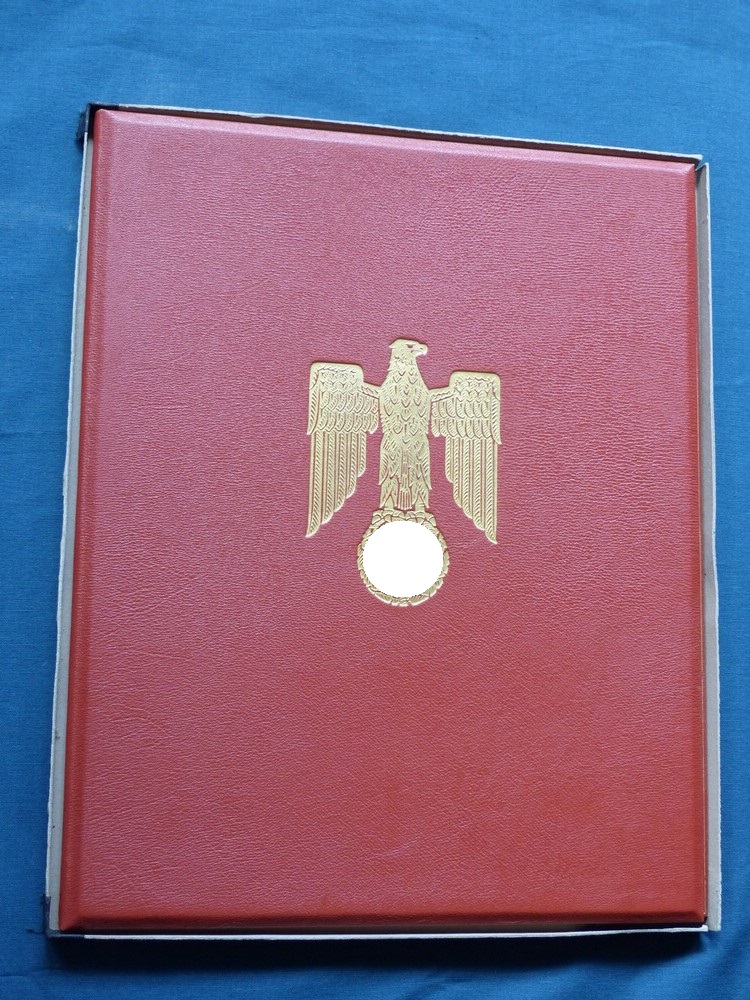
Let’s go a few years back when I had the chance to buy my first Knight’s Cross Red Leather Folder or Knights’ Cross Map. As far as my information are right there should be only 420 Maps out there!!!
Here is the story:
A gentlemen called me and asked me if I want to buy a KC Map from a higher ranking officer of the Army. My hands got sweaty and I said that I am interested, depends on the price he asked for. The price was OK and he sent me pictures via Email. Nice Map, all how it should be an we made an appointment close to Hamburg. Two days before the meeting he called and asked if I like also the cardboard protection for it…..Well I told him that it would be just great to have it too. So I checked the net to get an idea how a cardboard for the KC Map looks like and what I have to check before I finally buy it.
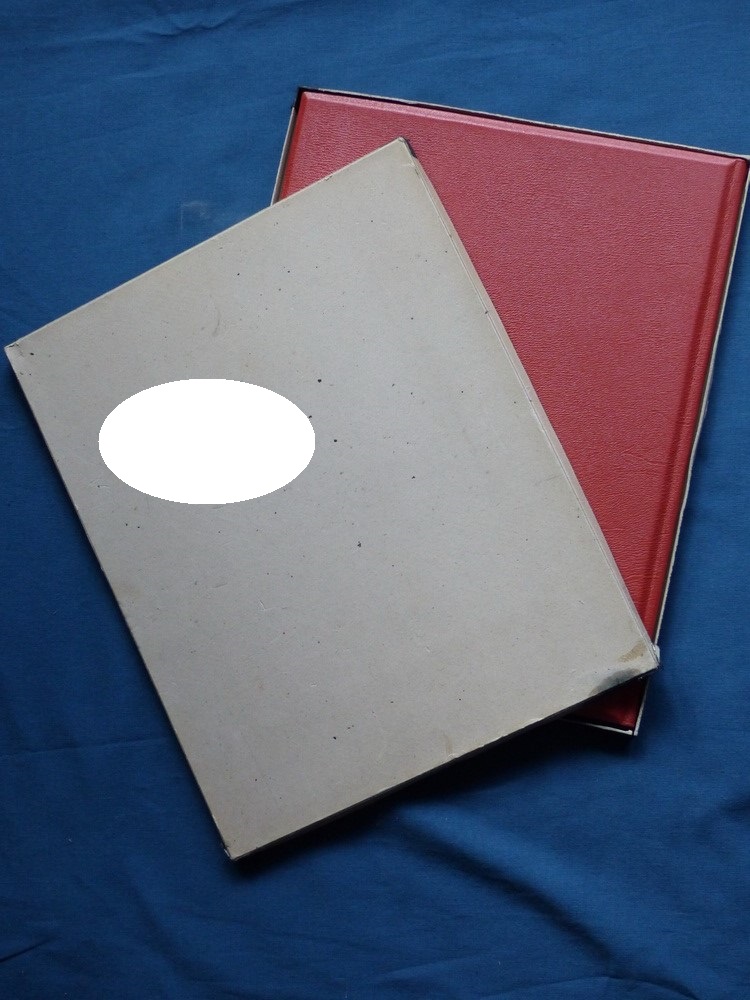
The ”purchase” day came and I went all the way to Hamburg to meet the seller. It was a nice little restaurant were we had lunch and later on we were planning to make the deal in a room away from the guests.
He had a big bag where the “holy grail” was inside. Unpacking it I was disappointed. Yes, it was a nice KC Map in a good condition, but the cardboard was only a painters cardboard of the size where a KC Map fits in.
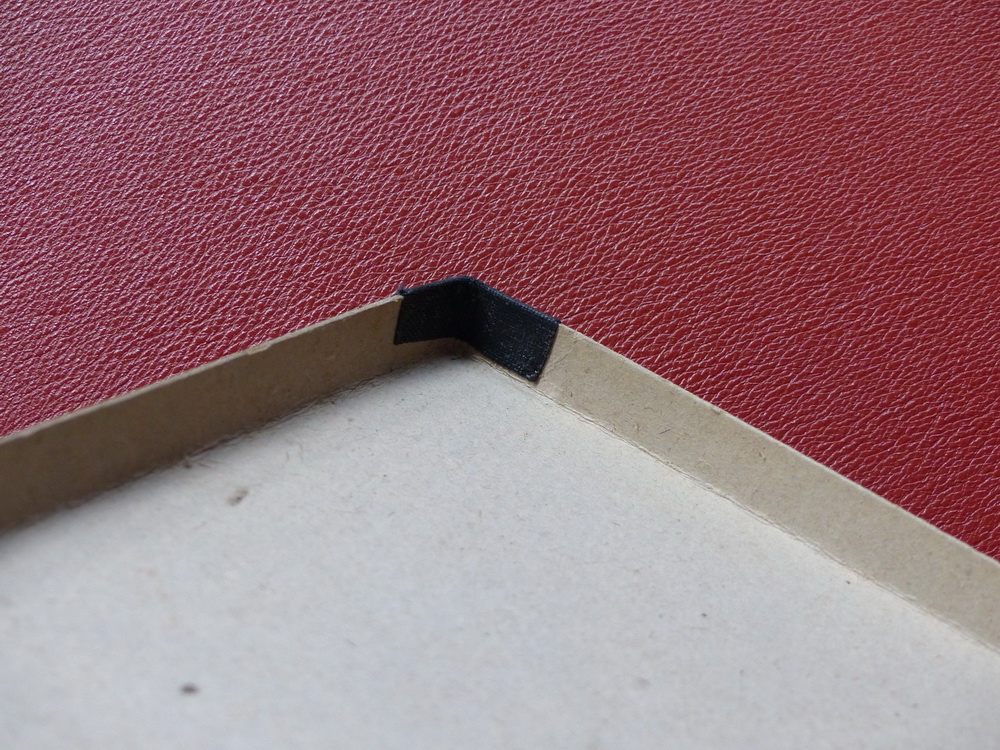
Well, no problem. I bought the Map and brought it all home.
Nice one, pretty good condition and nice to have. But as you all know….you cannot keep everything. So I sold it a few years later. I told myself that I can`t keep one without the cardboard ;-))….had to let it go!
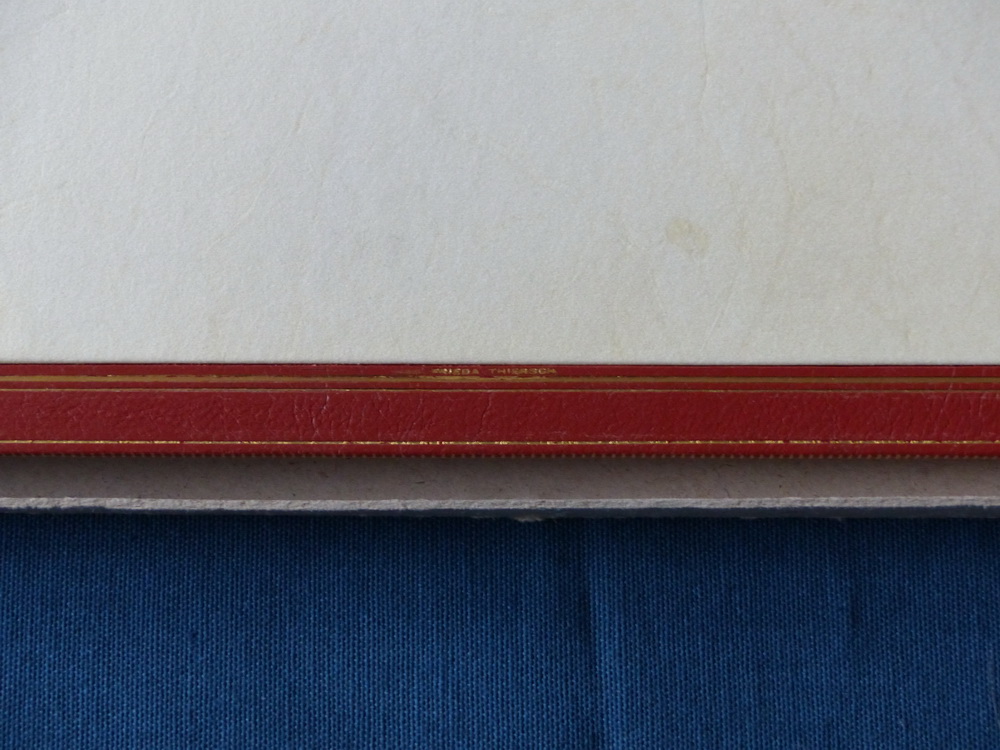
Scanning the net for nice KC Maps you can find one from time to time with the cardboard together. More expensive but very interesting to see. That time I asked myself if the cardboard cases are all made the same way, with the green corner protections and the writing on it……Yes they should all be the same.
Lucky me, a few months ago I got a big fat KC Map in my hand to study it and here you see what it looks like.
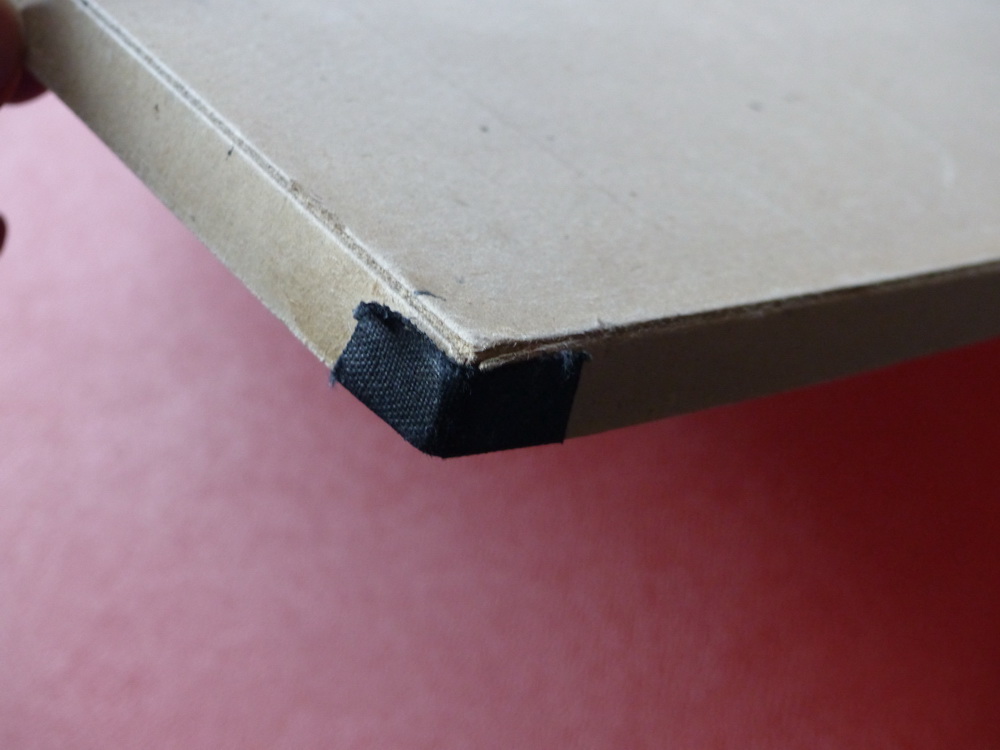
My plan was to give you all the measurements and the weight and so on and so on. But a good friend told me (and he is so right with is). If I give all the data, the forgers will start doing fake cardboard boxes for the Maps…..
So if a big Red Map is offered to you and it is in a cardboard, just drop me a line via email and I give the measurements to you. That way we can be sure you don’t get recycled crap in your hand.
But before come to the end the historical background to the Knights Crosses for you:
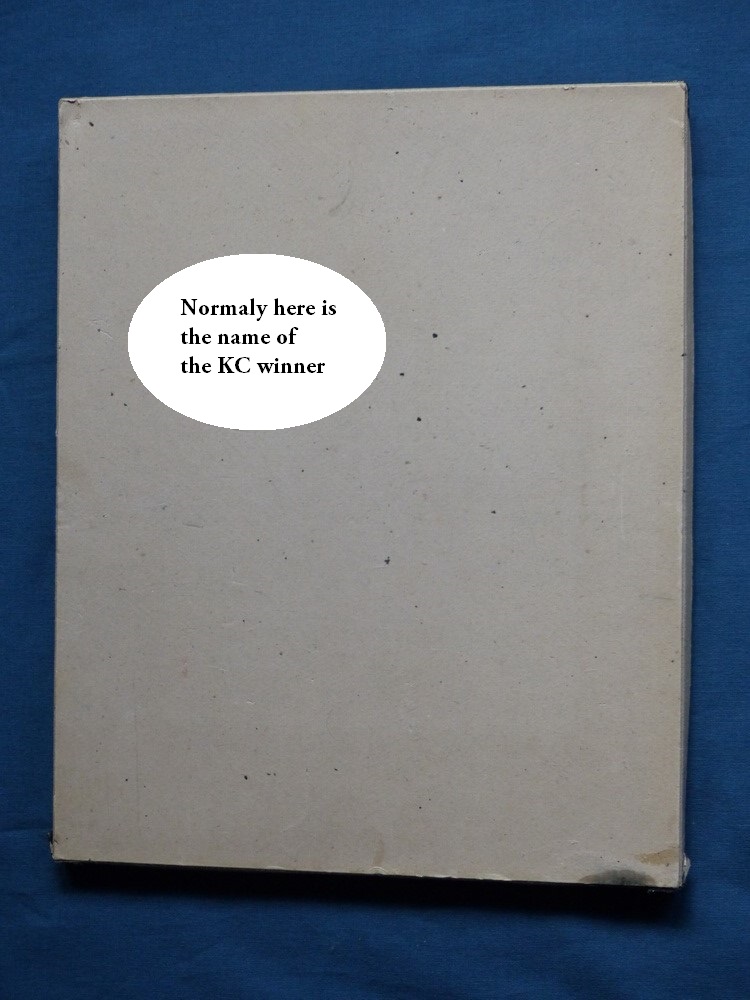
On March 10th, 1813, Prussian King Friedrich Wilhelm III established the Iron Cross as a temporary gallantry award for bestowal during times of war. Originally the Iron Cross was introduced in three grades with a Grand Cross intended for award to Senior Commanders for successfully leading troops in combat and the First and Second classes for award to all ranks for bravery or merit in action. The Iron Crosses were reinstituted by King Wilhelm I on July 19th, 1870 for award during the Franco-Prussian War and again on August 5th, 1914, by King Wilhelm II for award during WWI. On September 1st, 1939 Hitler once more reinstituted the Iron Cross series of awards in the First, Second and Grand Cross Classes and established the new Knight’s Cross of the Iron Cross. Hitler reserved the right to personally authorize bestowal of the Knight’s Cross and all ranks were eligible for the award. Originally the criteria for bestowal of the Knight’s Cross was outstanding personal bravery or decisive leadership in combat but this was later expanded to include personnel who had continually demonstrated exceptional acts of courage or an extremely high success rate on the battlefield. The Knight’s Cross of the Iron Cross was the most coveted award of the Third Reich period and those presented with it were elevated to the status of a national hero. In total it is estimated that roughly 7,360 Knight’s Crosses were awarded during WWII, a relatively small number when one considers the amount of troops fielded and the magnitude of the war. Due to the prestige of the award personnel who could afford it would opt to buy a jeweler’s copy for everyday wear with the actual award being put away for safe keeping. Of Note: The LDO, Leistungsgemeinschaft der Deutschen Ordenshersteller, (Administration of German Medal Manufacturers), began regulating the manufacture of German awards in March 1941 as a quality control agent for awards that were intended for retail sale and manufacturers were to use an assigned LDO, „L“, code on their products destined for retail sales. 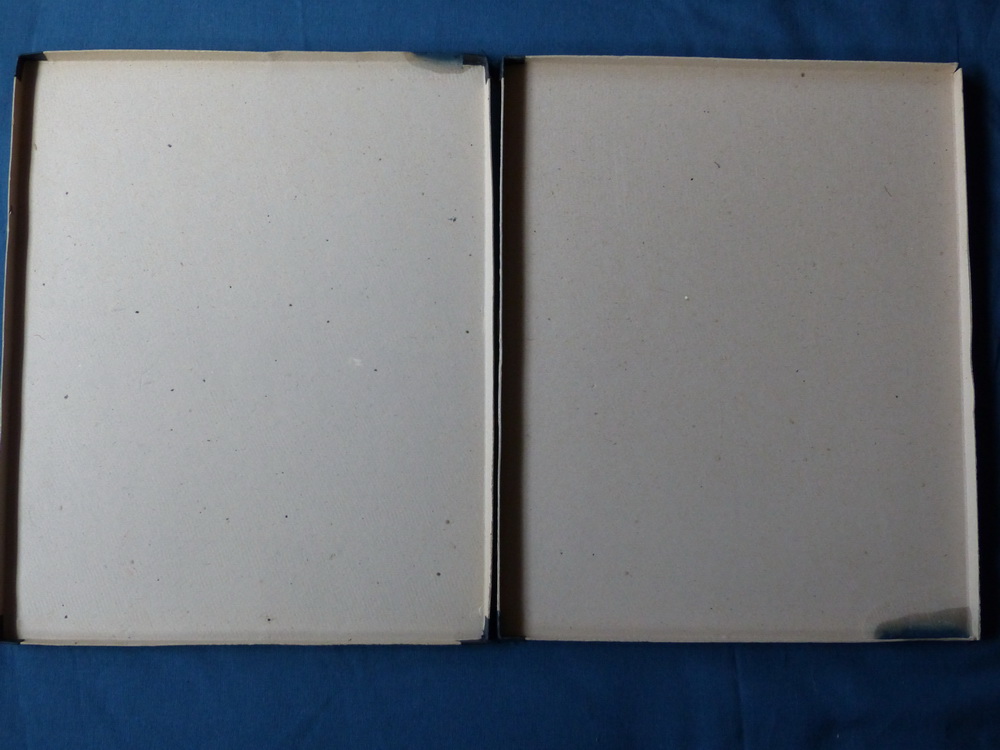 Awards that were to be bestowed by the government were also issued an official numerical government contract code known as a, Lieferantnummer, (Contractors Number), that was issued by the Präsidialkanzlei des Führers, (Presidential Council of the Führers), for formally approved manufacturers. The manufacturing firms that were licenced by both the Präsidialkanzlei des Führers and the LDO and would have used the same dies to stamp both the official issue and retail sales types of awards making them virtually indistinguishable from one another except for the markings. Regulations of November 1st, 1941 prohibited further manufacturing of the Knight’s Cross for retail sale. Of Note: On June 3rd, 1940 a higher echelon of the Knight’s Cross was established with the introduction of the Knight’s Cross with Oak-Leaves and on July 15th, 1941 an additional two higher grades of the Knight’s Cross with Oak-Leaves were introduced with the establishment of the Knight’s Cross with Oak-Leaves and Swords and the Knight’s Cross with Oak-Leaves, Swords and Diamonds. Finally on December 29th, 1944 Hitler established the final grade of the Knight’s Cross with the Golden Oak-Leaves, Swords and Diamonds. Also of Note: The Grand Cross of the Knight’s Cross was only awarded once to Reichsmarschall Hermann Göring and the Knight’s Cross with Golden Oak-Leaves, Swords and Diamonds was also only awarded once to Oberstleutnant Hans-Ulrich Rudel.
Awards that were to be bestowed by the government were also issued an official numerical government contract code known as a, Lieferantnummer, (Contractors Number), that was issued by the Präsidialkanzlei des Führers, (Presidential Council of the Führers), for formally approved manufacturers. The manufacturing firms that were licenced by both the Präsidialkanzlei des Führers and the LDO and would have used the same dies to stamp both the official issue and retail sales types of awards making them virtually indistinguishable from one another except for the markings. Regulations of November 1st, 1941 prohibited further manufacturing of the Knight’s Cross for retail sale. Of Note: On June 3rd, 1940 a higher echelon of the Knight’s Cross was established with the introduction of the Knight’s Cross with Oak-Leaves and on July 15th, 1941 an additional two higher grades of the Knight’s Cross with Oak-Leaves were introduced with the establishment of the Knight’s Cross with Oak-Leaves and Swords and the Knight’s Cross with Oak-Leaves, Swords and Diamonds. Finally on December 29th, 1944 Hitler established the final grade of the Knight’s Cross with the Golden Oak-Leaves, Swords and Diamonds. Also of Note: The Grand Cross of the Knight’s Cross was only awarded once to Reichsmarschall Hermann Göring and the Knight’s Cross with Golden Oak-Leaves, Swords and Diamonds was also only awarded once to Oberstleutnant Hans-Ulrich Rudel.
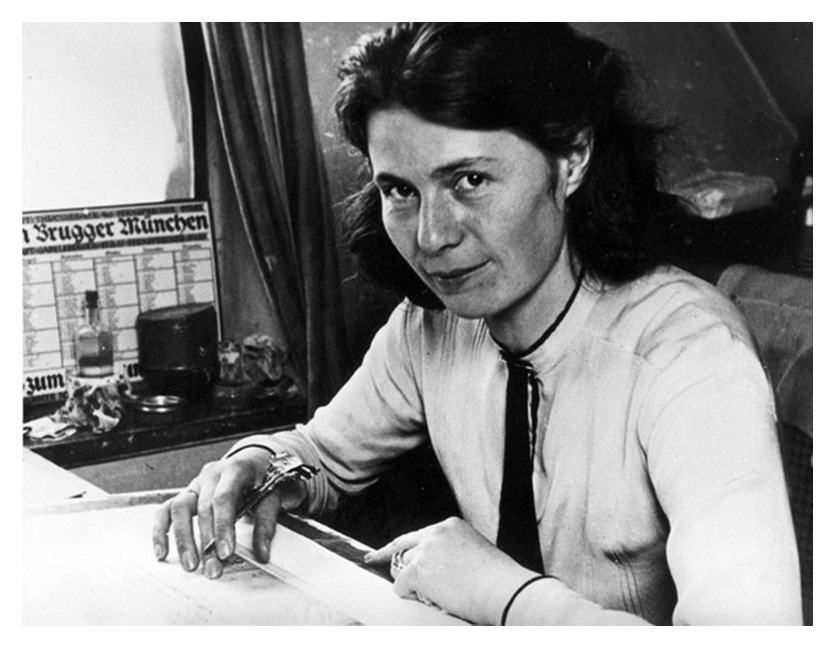
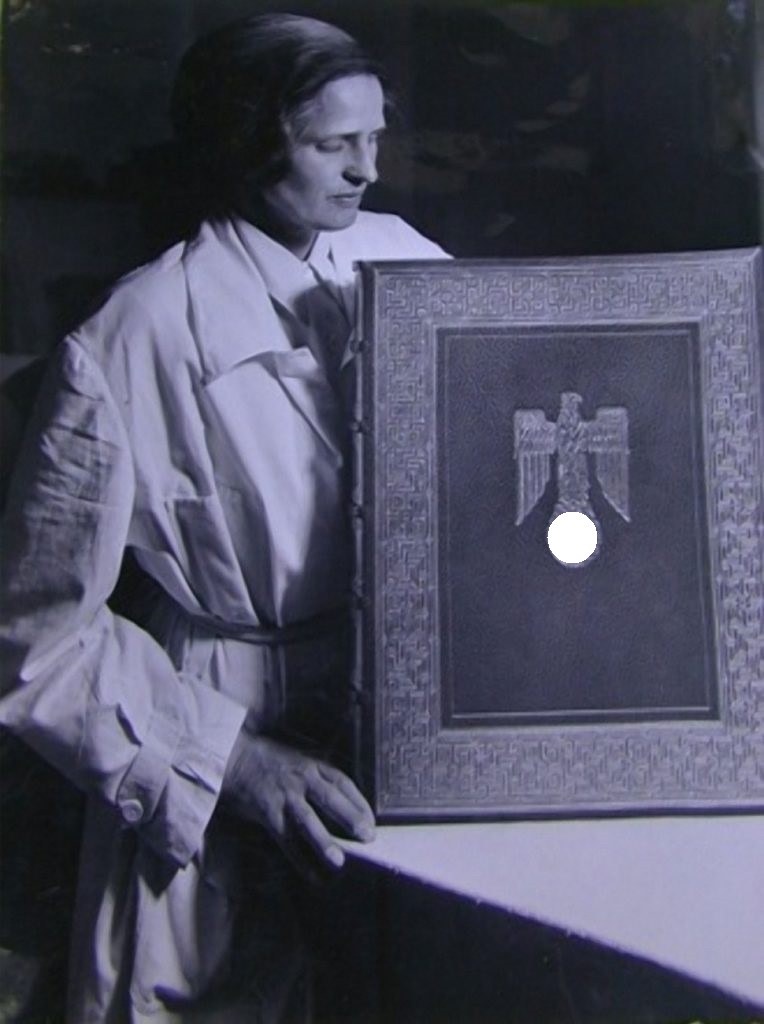
Here we have also another example how the Maps were delivered, wrapped in protective paper and in the cardboard box. Picture came from Frank Scholz /Scholz Militaria. Thanks Frank !!
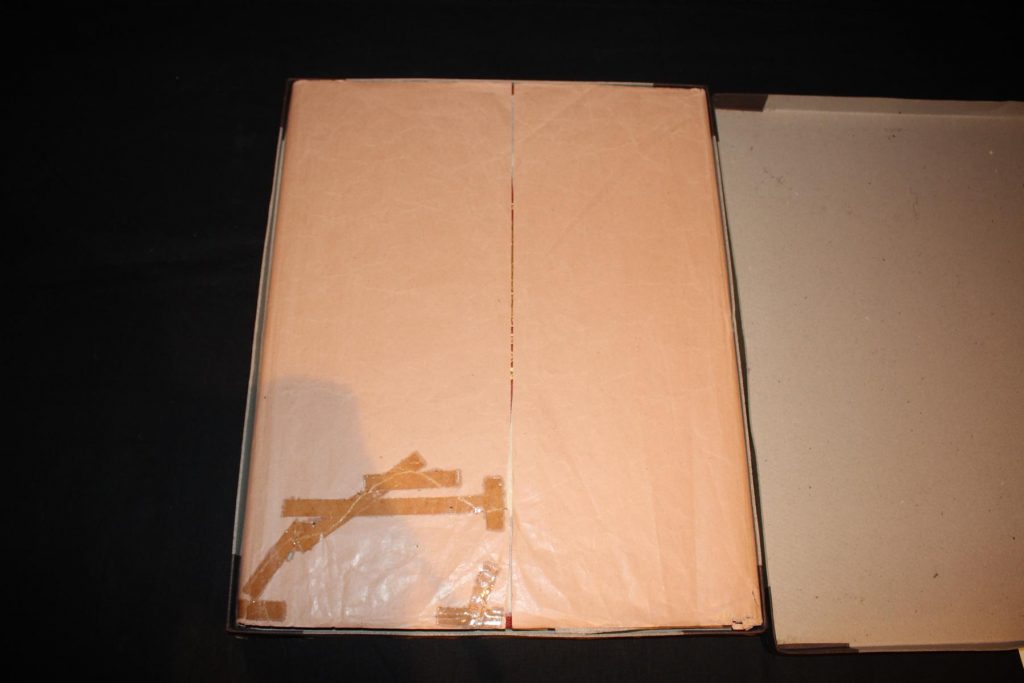
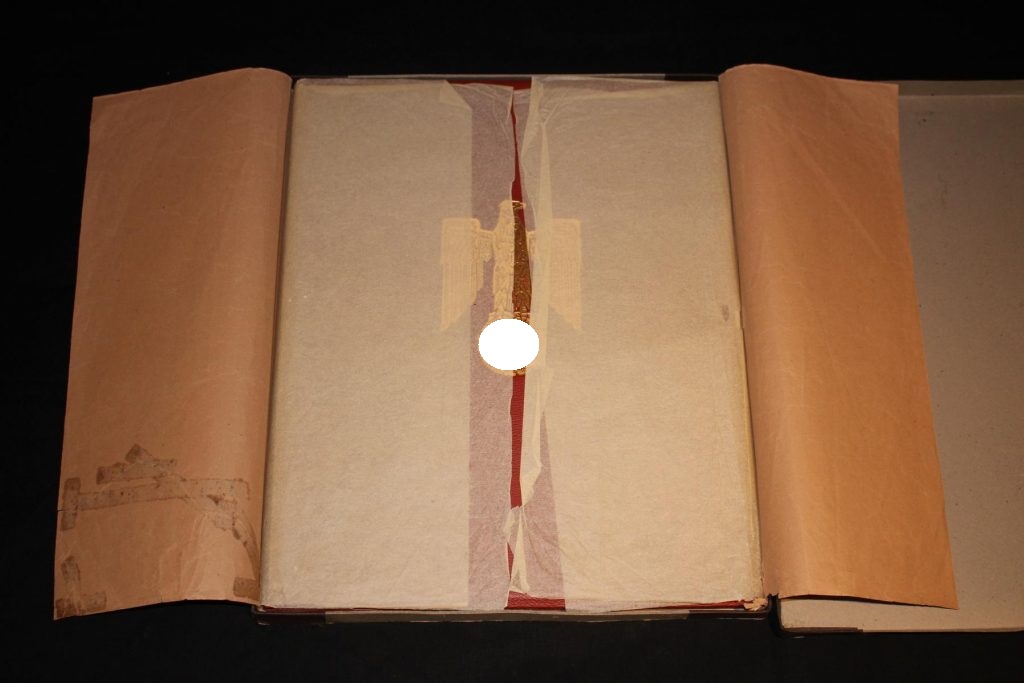
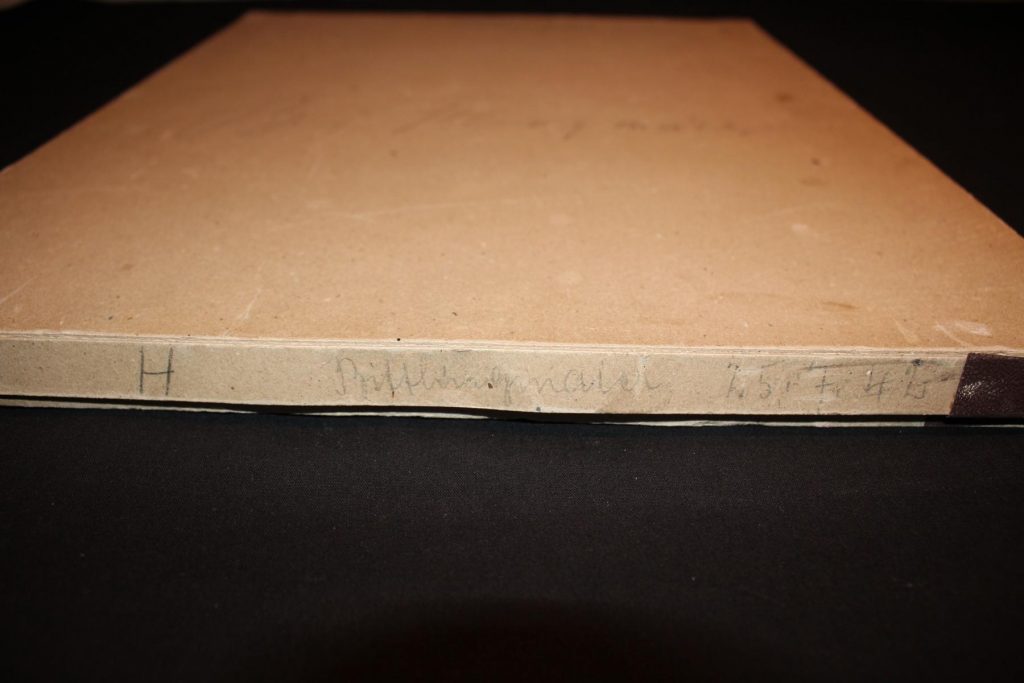
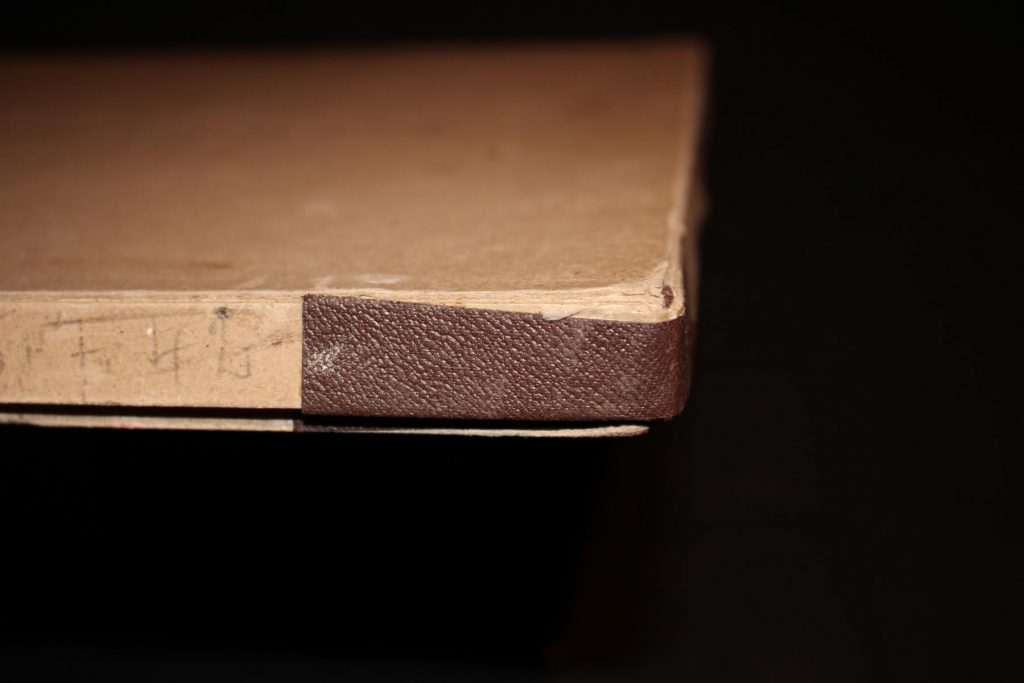
Finally I foud some pictures of Reporduction cardboards, so here you have an idea what they look like.
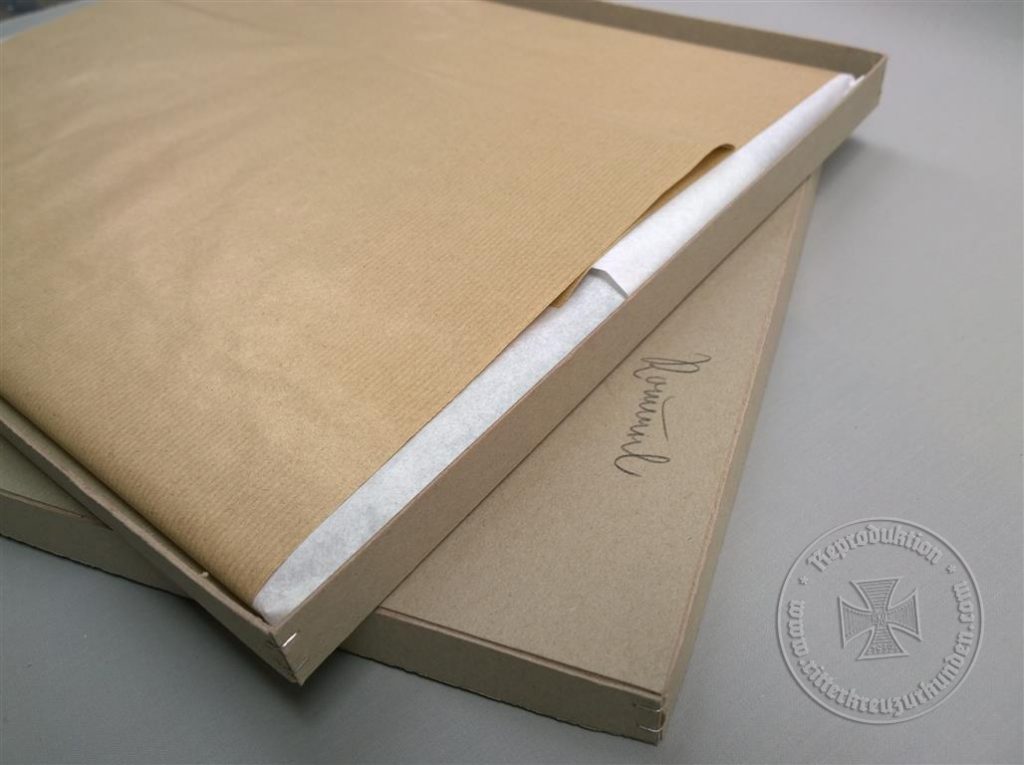
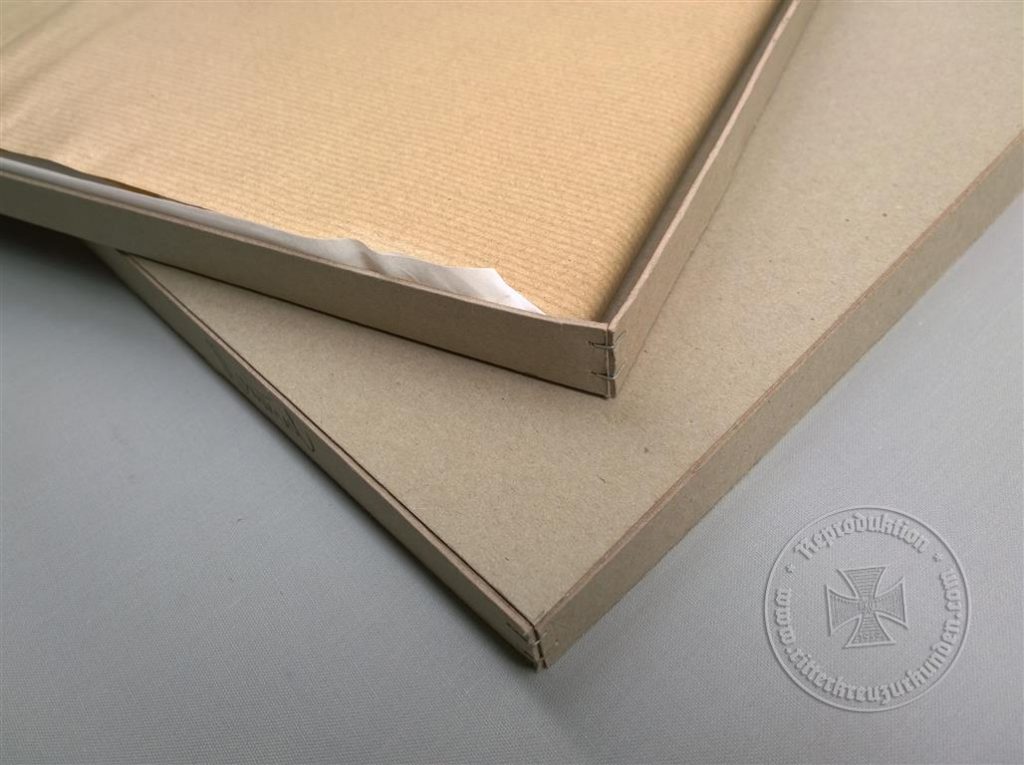
So all the bst and GOOD HUNTING !!
If you like what your read, give me a like on Facebook
Take care
Best
Sascha
„Subscribe“ / „abonniere“
Copyright 2019 : Alle Rechte bei dem Verfasser Sascha Ulderup
Honor Roll Clasp of the Army and SS / Makers ?
Hi Gents,
winter time is coming and that is always the beginning of bringing your nose close to the books for research and reading interesting stuff about our hobby. I can tell you that the last three months were like a ride on I ship in stormy weather. Having a full time Job and besides starting a new business with my friend and partner Dennis is not so easy.
For those of you who are thinking about starting an Auction House with a real building where you can sit down and raise your hand to get something you are looking for, don’t do it……;-)
So much work and money to get it going…..incredible to tell you all the problems you can find on your way to the finish line. But if it works it will be somethings special.
From working on lights and electronics up to the right software for your frontend and backend is pure horror. Little things like getting somebody to work on you outside signs or get all the paperwork together in the local town hall making you crazy.
A really positive thing is that we found the best employee’s you can wish for. Finding people who love what they are doing is a pleasure to work with.
The workload and my duty time in the German Navy left not much time to study badges and write something about it on the BLOG.
About four weeks ago I wanted to do a special on the honor clasp of the army, but I did not find the time. Finally, I put the story of Feldwebels Theodor Kurpisz in the blog which was close to the topic honor roll clasps.
Enough wailing, let`s get it on.
I had the opportunity to look over the information what the WAF Member “Honor” brought together.
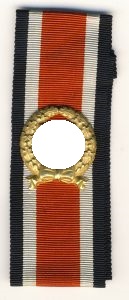
I don’t want to steal it all, so I tried to get in touch with him. The idea was that he writes something about the Honor Roll Claps here on the blog. But no chance to get in contact with him. So all I put in here is 80% from HONOR, so all the credits to him and not to me. “Thanks buddy for the very good research on that topic”.
Also “Norm F” from Canada and “90th Light” from New Zealand did a good job putting even more information together. Also a big credit to them for the great work.
With that much of data and pictures I put it all together in a more “light” information blog on that topic. I don’t want to go THAT deep in it because my friend Brian Razkauskas works actually on a book about clasps.
So if you read this and you like what you see, do the next step and buy his book as soon as it is on the market. I will let you know asap.
Ok, let`s start with some historical background on the honor roll clasp itself:
The „Ehrenblatt der deutschen Heeres“, (Honor Roll of the German Army) was established in July 1941. These lists were created as a record of honor to register the names and heroic actions of personnel who performed extraordinary service in combat. Although considered a great honor to be registered on these lists there was no insignia awarded to the personnel as a visible sign that they were listed on the honor roll. This was remedied by the army on January 30th, 1944 by creation of the „Ehrenblatt-Spange des Heeres“, (Honor Roll Clasp of the Army). The clasp was designed to recognize heroic acts by those who already held the Iron Cross 1st and 2nd classes, but for which the German Cross in Gold or the Knight’s Cross would not be suitable. The Honor Roll Clasps were worn mounted on an Iron Cross 2nd class ribbon and worn inserted through the second top front closure button hole of the field-blouse and service tunic. It is estimated that the army awarded just over 4,500 clasp in total before war end.
For me as a medal and badges collector it is always the goal to get one from the army, one from the Luftwaffe and one from the Kriegsmarine (by the way the Kriegsmarine has not an Ehrenblattspange, there it was the Ehrentafelspange).
But to be honest I did not buy one in the last five years for my collection. Always when somebody offered a nice one, I passed it and spent my small collector money for other awards.
But looking closely to the honor Roll claps of the Army, you can see some different ways they were manufactured. That is good to know if somebody offers a nice one to you but you have no idea that this is a real one made by a different maker and you pass on it.
Using HONOR´s Information and some other sources we have actually FOUR different Honor Roll claps of the Army /SS.
- Two-piece Construction, massive Swastika molded to the outer circular oak-leaf wreath. Pins are round wire and sharp at the end. Arms of the swastika are granulated /grainy. Maker is the company Otto Klein, Hanau.
- Two-piece Construction, massive Swastika molded to the outer circular oak-leaf wreath. Pins are round wire and sharp at the end. Arms of the swastika are NOT granulated /grainy. Maker unknown. Possible Juncker made clasp.
- Hand cut out, one-piece construction, hollow swastika in a hollow circular oak leaf wreath. Pins are flat wire short and sharp at the end. You see that swastika is cut out by hand! Possible Juncker made Clasp.
- Trimming Stamp one-piece construction, hollow swastika in a hollow circular oak leaf wreath. Pins are flat wire long and not sharp at the end. Possible Juncker made Clasp
We go through the different models so you can actually see the differences in shape and also production details.
Let`s start with the most common Honor Roll Clasp Army / SS – to short it only HRC.
The maker is the company Otto Klein from Hanau, Germany. Always a two-piece construction which comes in a black case with a white inlet. The cross is massive and moldered to the wreath. Surface of the cross front side is flat and not “grainy”.
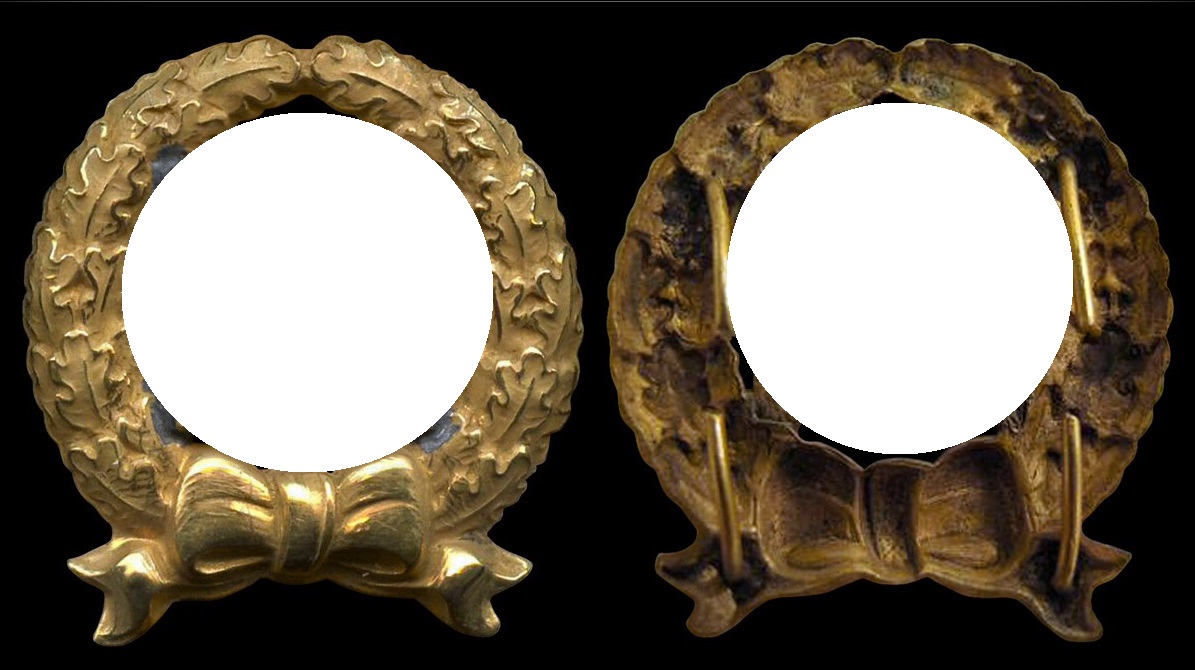
The second one also a two-piece construction. Massive cross in a hollow wreath, round wire prongs and you can see the “hand work” on the cross itself. The surface of the cross is “grainy”. As far as I can say that one was made by Juncker and it comes in a blue case with blue inlet.
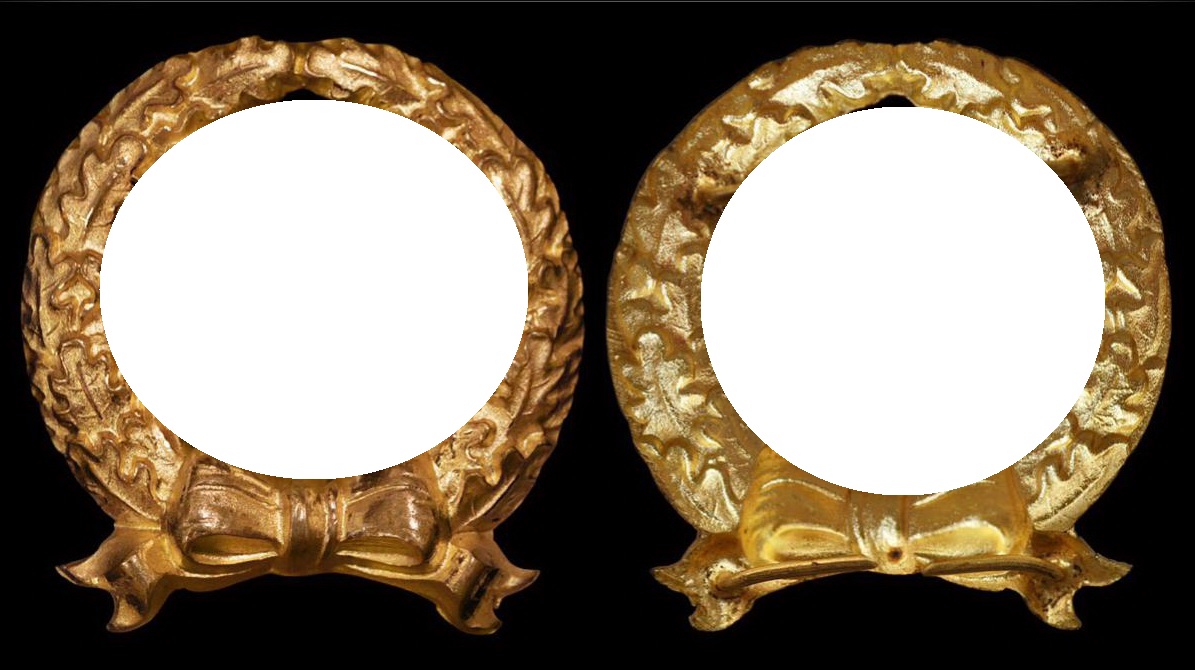
The third one is hollow made one piece HRC with short flat wire prongs on the backside. That one is a hand cut piece because you see the way the trimming tool was used to cut out the cross itself. Also possible Juncker made and found in a blue case with blue inlet.
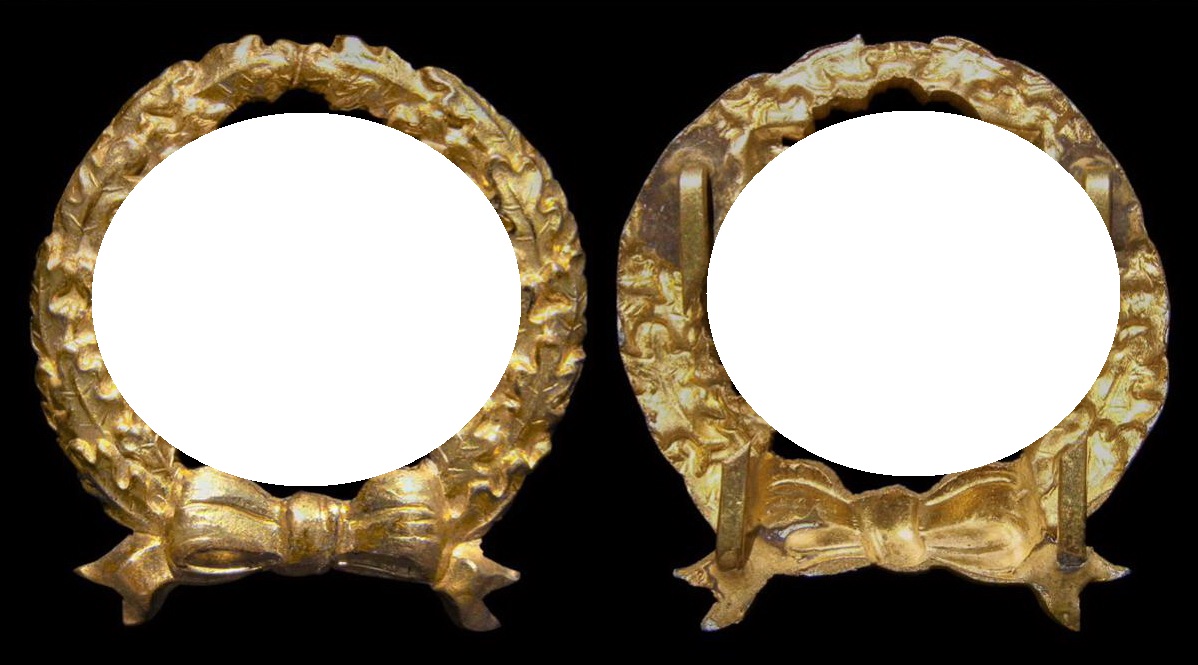
The last one is also a hollow made one piece HRC with flat wire long prongs on the backside. That one was made with a trimming stamp and there are no signs of hand work for the finish.
Also possible Juncker made and found in a blue case with blue inlet
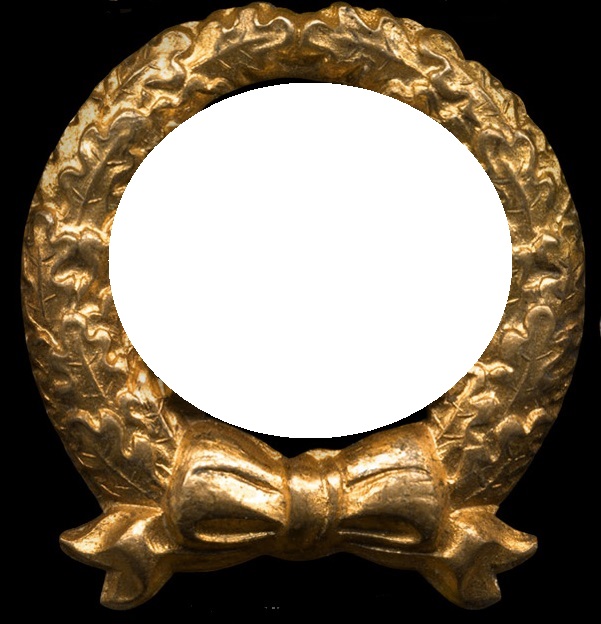
Here you can see the difference between trimming stamp and hand cut HRC, Zoom in for Details !
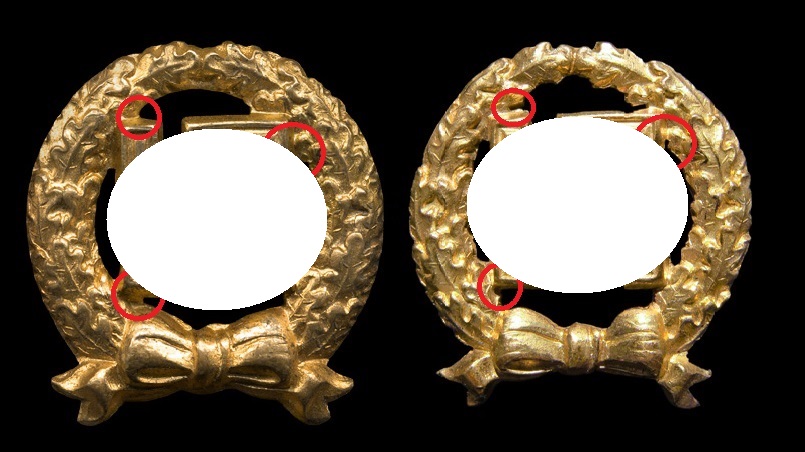
Finally, the backside picture to get an idea of short and long prongs.
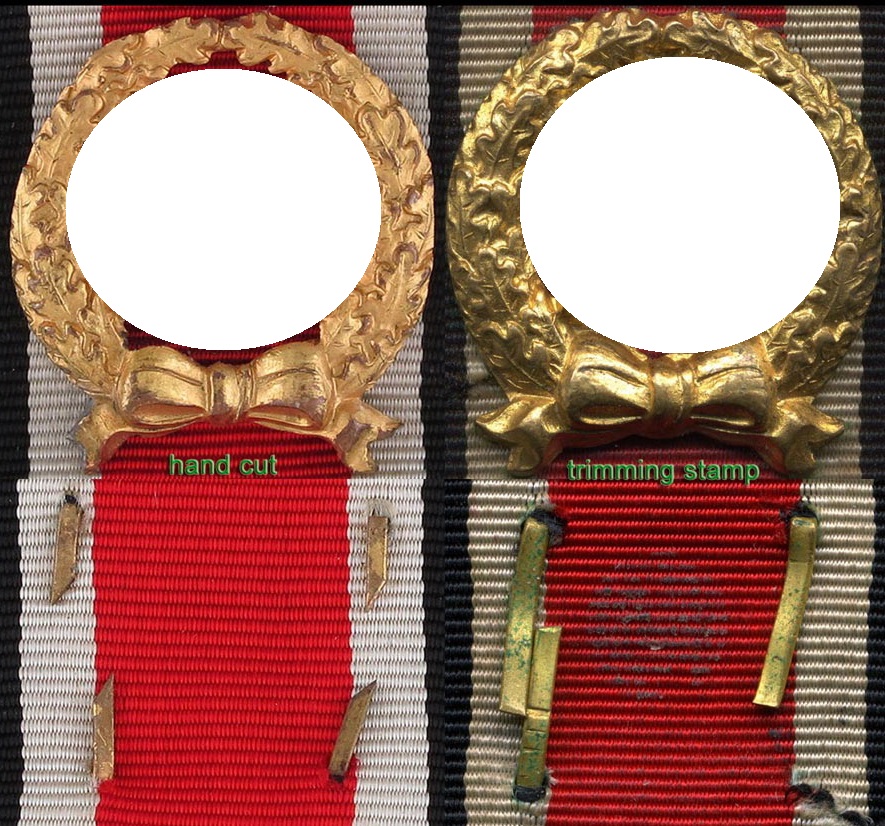
I think that might be deep enough to get an idea of the different models. Anything else like details on cases, packages and paperwork you will find in Brian’s book.
If you like what your read, give me a like on Facebook
Take care
Best
Sascha
„Subscribe“ / „abonniere“
Copyright 2018 : Alle Rechte bei dem Verfasser Sascha Ulderup
Narvik Shield Luftwaffe and a little bit more…..
Hi Collector friends,
after the hard Eastern time with the family and lots of good food (and beer) we have to go back to our hobby. Like I wrote it before, during the dark winter time there are enough free hours to scan the own collection and dig deeper into some of our lovely pieces and their history. Sometimes only to get more information about the variation or to get more information about the story behind the medal or badge.
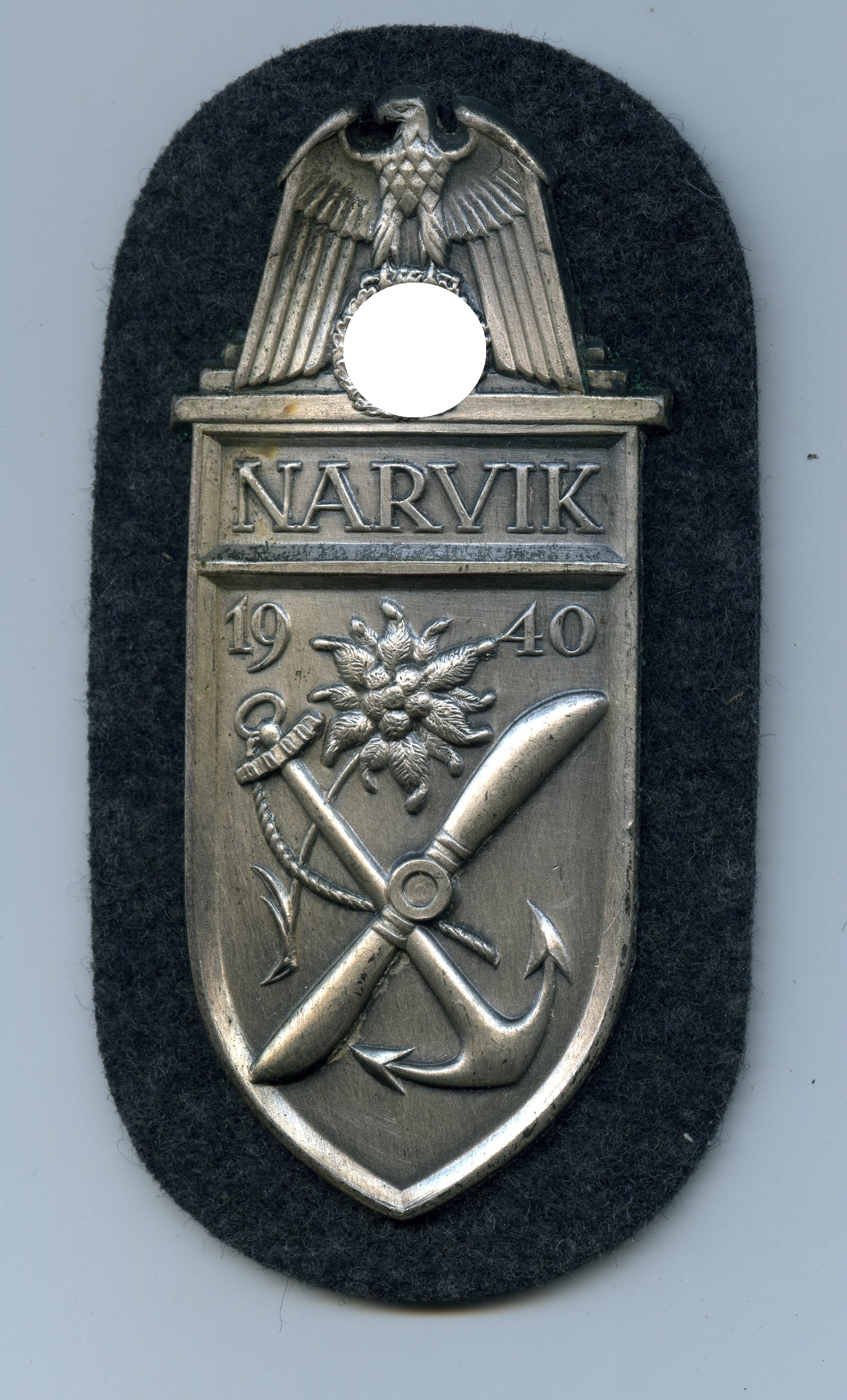
So I grabbed my two Narvik Shields which I usually keep in my bank locker and scanned them closely. After checking my books to get more information I contacted Pascal H., one of the leading shield experts I know (and probably most of you know him too….).
I send him a scan of my silver Narvik Shield which I got years ago from the family of the soldier. Remembering the story how I got it, I searched for a picture of the day the pieces arrived by mail at my place.
Here you see what they sold me. There were three unworn Luftwaffe Narvik Shields and Flak Badge of the Luftwaffe (cased). All wrapped in and signed by the unit which reads “Dienststelle L10480”
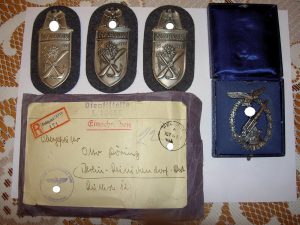
I searched for the Number 10480 and found this:
10480
(Mobilmachung-1.1.1940) 6. Batterie Flak-Regiment 13
dann 6. Batterie Flak-Regiment 33
(28.4.1940-14.9.1940) 1. Batterie Reserve-Flak-Abteilung 1001
(15.9.1940-31.1.1941) 1. Batterie Reserve-Flak-Abteilung 605
(1.2.1941-11.7.1941) 3. Batterie Reserve-Flak-Abteilung 111
(27.1.1942-14.7.1942) 3. Batterie schwere Flak-Abteilung 111
(25.1.1943-31.7.1943) 3. Batterie gemischte Flak-Abteilung 111
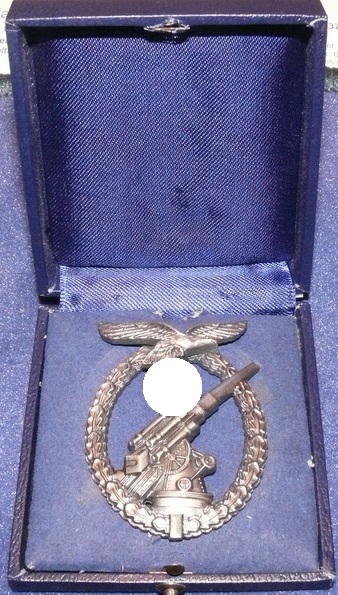
That day I was happy and put all of it to my collection. All shields were unworn and in really TOP condition. Sadly after I called the family again and asked for paperwork and pictures they told me that that’s all there was……
Back to Pascal, he told me that my shields are the version with the name “snaggletooth” type. The name came from Mr. Frank Heukemes who did also a lot of research about campaign shields.
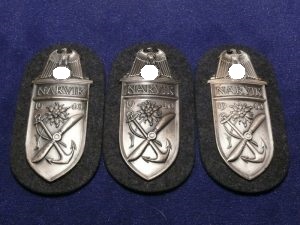
Funny name but in fact these type of shields are easy to recognize as this is the only type of shield were the wings of the eagle don’t touch the bar (under the bird).
If you look back to the picture with the three shields, it is hard to believe that they were given posthumous to the soldier. In case of a K.I.A there is one only shield shipped home. Maybe he was awarded three of them and died later in the war….So they send all medals and badges he had home. We will never know…..
Here are some details on my shield:
Size without fabric:
36 mm wide and 91 mm high
Size over all:
55 mm wide and 102 mm high
The weight is about 31 Gramm, it got 4 prongs and it is not magnetic.
More Background
The Narvik Campaign shield was the first of a series of campaign shields to be introduced and was established by Adolf Hitler on August 19th, 1940 for award to all Wehrmacht, (Armed Forces), personnel who participated in the battle of Narvik / Norway between April 9th and June 9th, 1940. Of Note: Although the shield was officially introduced on August 19th,1940 it wasn’t until September 12th, 1940 that the OKM, “Oberkommando des Marine”, (Navy High Command), published the issuing order, followed by the Luftwaffe, (Air-Force), the next day. The Kriegsmarine version of the shield was gilt washed while those awarded to Heer, (Army), and Luftwaffe personnel were silver washed. The shields were bestowed by Generalleutnant Eduard Dietl the commander of Army Group Narvik and it is alleged that a total of only 8,577 shields were awarded to all branches of service personnel. The shields were to be worn on the upper left sleeve of the uniform. The color of the backing material was to match that of the uniform it was to be worn on.
Finally I got information to my shield, learned again something about different versions and maybe that was interesting for you, too.
Best
Sascha
Copyright 2018 : Alle Rechte bei dem Verfasser Sascha Ulderup / All rights with the author Sascha Ulderup
Cuff Title Fallschirmjäger-Regiment 1
Well Friends,
with the cuff title of Fallschirmjäger Regiment 1 there is special connection. In 1995 I was with my ship „Zerstörer Rommel“ (a german destroyer DDG 103 B) on basic operational sea training in England. During a visit in the city of Plymouth I found an antique store which also sold some medals and badges. There was a Fallschirmjäger Regiment 1 cuff title and I bought it for small money (think it was about 150,- DM which are now 75,- Euro)
Happy to bring it back to Germany and I put it in my collection.
Years later I found out it was a fake on…..lesson learned 😉
All the regiment cuff titles you see here are originals !
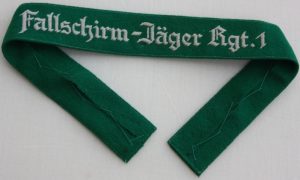
These cuff titles were manufactured from dark green badge-cloth, were 3.2 cm wide and were executed in “Frakturschrift” as follows:
– For Officers the cuff title was hand embroidered in aluminum thread and featured the addition of an approximately 3 mm wide aluminum braid (Soutache) edging.
– For NCOs, the cuff title had machine embroidery made of matt gray or whitish-gray cotton and featured an approximately 3 mm wide cotton braid (Soutache) edging .
– Although similar in material and color the version for enlisted men lacked the braid edging.
Very important to know is that the cuff titles of FallschirmJäger-Regiment 1 are the only ones were also cuff titles for enlisted men can be found which are HAND embroidered letters !!!!

Method of Wear:
The cuff title was worn on the Tuchrock just above the turned back cuff of the right sleeve. When worn by a soldier holding an appointment to the position of “Spieß”, it was attached just above the sleeve rings indicating this status. Officers also wore the cuff title on the Fliegerbluse and the white Summer Tunic. It`s evidenced by numerous photographs however, that the wearing of this cuff title was probably complied with less and less over the course of the war.
Note: A formal date of introduction was not discovered for the cuff titles with the names Regt. 4 and Regt.5 . One explanation for this would probably be that when examples of this cuff title are encountered they are mostly of makeshift appearance, fabricated by the troops themselves. In the relevant cuff titles, the original numbers have been removed and replaced by a rather coarsely embroidered 4 or 5.
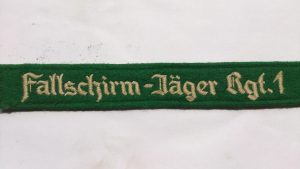
History Fallschirmjäger- Regiment 1
The formation of Fallschirmjäger-Regiment 1 began on April 1st, 1938, based around IV. (Fallschirm) Bataillon from „Regiment General Göring“. The battalion, consisting of five companies, was the main battalion of the “Fallschirmtruppe” and initially formed 1st battalion of the regiment in Stendal, which was subordinated to 7th Flieger Division under General Student, in the context of plans for use in the Sudetenland.
On September 1st, 1939 the former “Heeres-Fallschirm-Infanterie-Bataillon (Braunschweig)” joined the Luftwaffe as 2nd / 1 , and the “Luftlande-Bataillon General Göring“ (moved from Berlin to Gardelegen ) joined the Regiment as 3rd / 1.
In March, the three battalions were intended to be used as part of the 7th Flieger Division in occupying the rest of Czechoslovakia, but due to bad weather they did not take part.
After formation of a “Regimentsstab” in June 1939, Bruno Bräuer took over as the first commander of the regiment.
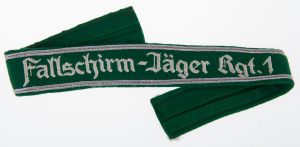
During the Polish campaign some missions were planned for 7th Flieger Division , however they were initially not used. Subsequently during the campaign however, parts of the regiment were used in ground combat at Radom and Pulawy .
In early April 1940, the 1st / 1 was prepared for use in Norway, where it went into action from April 9th, 1940. The German paratroopers took the airfields at Oslo-Fornebu and Stavanger-Sola and secured the Storstromme Bridge. Also the 1st company fought in the Dombas area.
For use in Belgium in 1940, parts of the regiment were detached to “Sturm-Abteilung Koch”. In addition, 1st and 2nd battalion received the order to capture the important bridges at Moerdijk and Dordrecht . The 3rd / 1 was to occupy the airfield at Waalhaven, land a platoon on the outskirts of suburban Rotterdam-Feyenoord and capture the Rotterdam bridges. 3rd battalion achieved its goals, and the 1st and 2nd / 1 also fulfilled their duties, albeit with heavy losses. The days which followed were taken up in determined fighting to hold the positions which had been captured. The regiment contributed significantly and at the foreground of the successes of the paratroops in the western campaign.
At the end of May 1940, the regiment was moved to Norway and supported the struggles in the Narvik area with General Dietl.

After the conquest of the Balkans came the task of occupying the island of Crete, as part of operation „Merkur“. The regiment was employed in the 2nd wave, as part of “Gruppe Ost”, to occupy the city and airport of Heraklion. This task, after suffering heavy losses on the first two days of the operation (2nd / 1 lost about 400 men), could not be achieved and so the regiment was given the task of holding the enemy and preventing the use of the airfield. On May 29th, 1941 the airfield and the town of Heraklion were occupied after being evacuated by British troops. With this, the eastern part of the island also capitulated and 200 Fallschirmäger prisoners could be freed. Among the 3,094 fallen paratroopers were numerous members of Fallschirmjäger-Regiment 1.
After the end of the fighting, the regiment was the first paratrooper unit to be moved back home and in August they arrived at the “Truppenübungsplatz” Bergen-Hohne. The 2nd / 1 was temporarily renamed as the “Fallschirm-Lehr-Bataillon” and the losses in Crete were more or less made up.
On September 24th, 1941 came the order to insert a Fallschirmjäger-Regiment into the area south of

Lake Ladoga on the northern section of the Eastern Front. The choice fell on Fallschirmjäger-Regiment 1, to take the place of the missing 2nd / 1, 2nd / Storm Regiment. With this action, the process began of removing the paratroops from their own specialist role and to use them as regular ground combat troops. Subsequently, the remaining parts of the 7th Flieger Division were also used in this manner and thereby suffered severe losses because of often used being used in a fragmented manner. Having arrived at the limits of their combat effectiveness in late November a return home was warranted but the increasingly deteriorating situation on the eastern front prevented this. Only in May 1942 was the refresh of almost all units carried out in Normandy, where the Regiment was given a new 2nd battalion. In mid-October 7th Flieger Division moved into the area of “Heeresgruppe Mitte”. In January 1943, the 3rd / 1 was moved into the Welikije Luki area, there to relieve an encircled “Kampfgruppe” at temperatures of -43 ° C. After a few quiet days bivouacked there, there was a major enemy attack, which the battalion withstood and was returned to the 7th Flieger Division on January 16th 1943. A short time later came an alarm involving the whole regiment near Orel, where it was replaced in March 1943 after the position was stabilized.
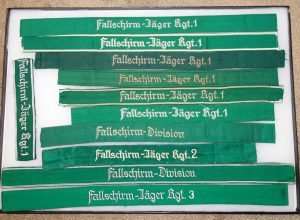
Between February and May 1943, 7th Flieger Division was renamed as 1 Fallschirmjäger-Division, into which Fallschirmjäger-Regiment 1 was also absorbed. At the end of April the Division was assembled in Normandy and was then relocated in May / June to southern France. The Division was located in the Rhone Valley. In March 1944, 3rd / 1. had been removed and used in the formation of the 3. Fallschirmjäger-Division. It was subsequently reformed.
In July 1943 came the action in Sicily, where a move of Fallschirmjäger-Regiment 1 by rail was carried out. During this movement, the regiment was stopped and moved into the area Eboli to be used in case of a possible Italian withdraw from its alliance with Germany.
In September the Regiment came under the control of its division at the Allied bridgehead at Salerno and then at Cassino. The regiment earned a legendary reputation there, but was eventually forced to retreat. In June in the area around Rimini, the regiment was one of the last German units to cross the Po. Withdrawing to the Alps, the Regiment rejoined the rest of the Division on May 2nd, 1945.
Hope that the Fallschirmjäger-Regiment 1 information was good for your hobby!
Subscribe for more and get an email every time a new article goes online !
Help us on Facebook to get to collectors all over the world !!
Best
Sascha
Copyright 2018 : Alle Rechte bei dem Verfasser Sascha Ulderup / All rights with the author Sascha Ulderup
General Assault Badge Screwback Clamshell
Hello Gentlemen,
during this cold and dark winter I have more time for checking the net for interesting badges. A few days ago I stumbled over a General Assault Badge with a screw back. Not a normal screw back as most of you know from Iron Crosses first class. I talk about the seashell screw back version. In Germany we use the term “Sternenschraubscheibe” which means star screw back.
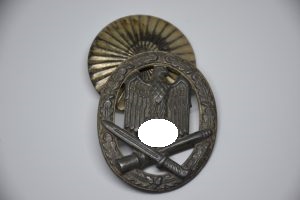
My collector friend Gabin Bruneau from France is the proud owner of that nice GAB. I asked for some pictures and more details about the badge and here we go.
The weight of the screw back: 5.85g
The weight of the badge: 27.75g
Both together: 33.60g
The measurements of the badeg are: 540 mm high and 445 mm wide. The screwback itself has 410 mm.
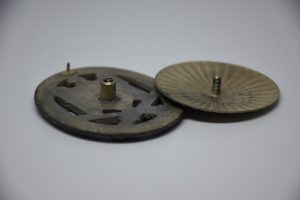
So in this case we have a General Assault Badge made by the company Alois Rettenmaier. If you look for this company you will see they are still in service and located in Germany, Schwäbisch Gmünd
Well, Alois Rettenmaier and seashell……maybe you remember seeing Infantry Assault Badges made by Rettenmaier before with this sort of backside. I started to search the net for more badges with clamshell screw backs and found some.
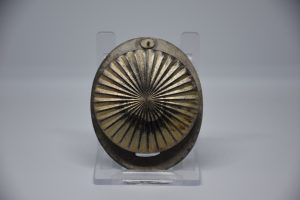
In the Luftwaffen Badge area I found some pilot badges, sadly just with normal screw backs, Kriegsmarine was the same, no luck there. Only one Uboat Badge but I think that was not a good one with the screw back…..
So I went on and found wounded badges from World War I with clamshells, Iron Crosses 1st class 1914 and Iron Crosses 1st class 1939 with that clamshell. Even on the clasp for the iron cross 1939 1st class we found them…..So they are out there but you have to be careful: Bad guys already know that the price goes up if there is a screw back instead of a pin….even better a seashell……watch out and get good information before you buy.
Let`s go back to the General Assault Badge. Searching for more information another collector friend provided me with pictures from his collection. There are 3 known makers which made clamshell screw backs General Assault Badges:
1.Schauerte & Höhfeld
2.Deumer
3.Alois Rettenmaier
And here are the pictures to the different GAB makers.
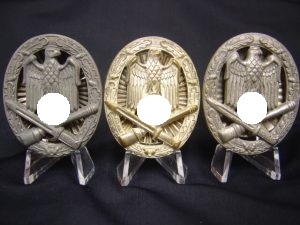
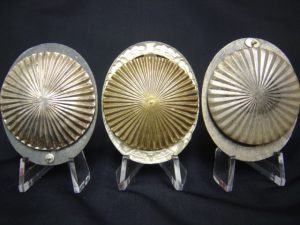
As always we need some historical facts to the General Assault Badge:
The General Assault badge was introduced on June 1st, 1940 by Generaloberst Walther von Brauchitsch, for award to support personnel who were ineligible for the Infantry or Panzer Assault badges. Criteria for award of the badge was basically the same as the criteria for award of the Infantry and Panzer Assault badges with the main qualification being participation in three separate assaults in a supporting role. On its introduction the badge was only intended for award to combat engineers and was designated, Pionier-Sturmabzeichen, (Engineer’s Assault Badge). Shortly afterwards award of the badge was extended to other support personnel including artillery and assault gun personnel, anti-tank and anti-aircraft personnel and medical personnel. Of Note: Before the introduction of the Tank Destruction Strip in March 1942, personnel who had single handedly destroyed an enemy tank with Infantry weapons were awarded the General Assault Badge.
Finally for the collectors of GAB`s or IAB`s who wants all varieties for their collection, it will be a hard way to get them all. I think they pop up here and there but because of the rarity they are already sold when you try to get them
Thanks again to all collectors who provided me with picture material. Some pictures are without any source, so if that is from your collection let me know. So I can credit it to your name.
Hope that the clam shell information was good for your hobby!
Subscribe for more and get an email every time a new article goes online !
Help us on Facebook to get to collectors all over the world !!
Best
Sascha
Copyright 2018 : Alle Rechte bei dem Verfasser Sascha Ulderup / All rights with the author Sascha Ulderup
Pilot Badge IMME by Sebastien Talbot
Hi Collector Friends, today I like to bring an article about the Imme Pilot Badge to you which was written by Mr. Sebastian Talbot who is a specialist in WW2 Luftwaffe Badges. Enjoy it.
Today I would like to present to you this J2 JMME pilot badge which holds much importance to me. When you collect, you tend to be drawn to a specific award for many reasons. This badge holds a special place in my collection since it was the very first one I acquired for my personal collection. Purchased from another collector and friend, Giel, more than a decade ago.
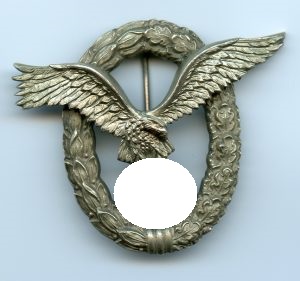
This badge dosen’t have anything rare or fancy, but represents a wide range of badges awarded during the mid war period. Made from Juncker wreath and eagle, this pilot badge was assembled by the JMME manufacture. The JMME signature in the hardware is the typical doomed nickel silver rivets and nickel silver C catch. The finish colour is particular to this maker with the nice goldish/greenish finish for both the wreath and eagle. Produced between 1939 to 1942, this badge was produced in a large number. Some rarer examples can be found with a darkened eagle and these were most likely darkened by Juncker firm.
The JMME pilot badge from this period came out with the presentation box with either early velvet or spray felt interior and paper hinge depending of the period distributed. The exterior can be either the two or three layers imprint on the cover.
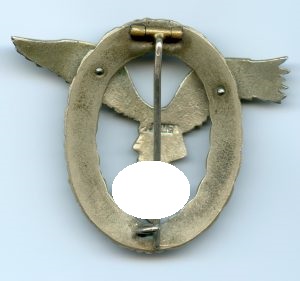
Historical Facts about the Pilot Badge:
The pilot’s qualification badge was originally introduced on January 19th, 1935 for award to personnel of the DLV, “Deutscher Luftsportsverband Fliegerschaft”, (German Air Sports Association, Pilot Base), the secret forerunner of the Luftwaffe, who achieved their pilot’s license. The badge was officially adopted by the Luftwaffe on March 26th, 1936, by order of Hermann Göring. The pilot’s badge was awarded on an individual basis to personnel who had successfully completed the appropriate theory and flight training and had achieved their military pilot’s license. As with other flyer’s specialty badges a cloth version of the pilot’s badge was authorized for wear on the flight blouse with a machine embroidered pattern for EM/NCO’s and a hand embroidered pattern for Officers. Of Note: Originally the cloth version of the pilot’s badge was only authorized for wear by Officers ranks until regulations of November 18th, 1937 extended the authorized wear of the cloth versions to EM/NCO’s. Further regulations of May 8th, 1942 discontinued production of the cloth versions although they continued to worn through-out the war.
Sebastien Talbot
Subscribe for more and get an email every time a new article goes online !
Best
Sascha
Copyright 2018 : Alle Rechte bei dem Verfasser Sebastien Talbot / All rights with the author Sebastien Talbot
The Lorient Shield
Hi gents, almost time to go back to our mace of good or bad high end shields of World War II.
I did the Cholm shield part one and got a lot of feedback from collectors with thumbs up and more good information. What I liked the most was the question if I can do a part two with the cupal example and the zinc version….I will do that but it takes some time.
By the way I would like to know if there are hobby writers among you guys. I would love to make this blog bigger with more articles but my time is endless. So if you like to do something on a special badge of World War II or something similar…..just contact me and we work it out. If you are from Germany don’t be afraid, if you write in german I can translate it for you 😉
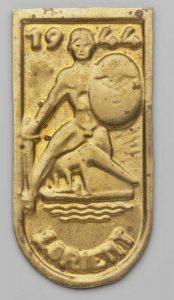
However back to our riddle of rare shields. Today I like to bring you some information on the Lorient shield and what happened there.
And (I think you already knew it) I have been to Lorient in the early 90´s and was impressed about the big Bunker`s which were build there during the war. Huge monsters made from concrete and steel to protect the German submarine from air raids until 1945 on the Atlantic coast. Lorient was the home base of the 10th. U-Flottilla (Unterseebootflottille). I was lucky to get a picture of the cap badge which Uboat crew member used to wear on their oversea cap (Schiffchen).
Here some background to the area of Lorient and historical facts:
Lorient, on the Bay of Biscay, had been an important French naval base until June 1940. With the capture of the base in the same month by German troops (see France campaign), the town in succession got more and more of strategic importance for the German Navy.
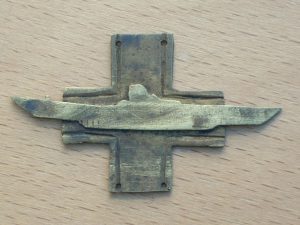
This concerned above all the submarine construction with its bunker buildings on the peninsula Kéroman.

In August / September 1944, following the Allied invasion of Normandy, the port and town of Lorient were completely enclosed by US and British forces, with some 22,000 German soldiers. Adolf Hitler thereupon declared the city a fortress. During the eight-month siege, which ended with the surrender of the remaining German forces on May 10th, 1945, there were some fighting going on.
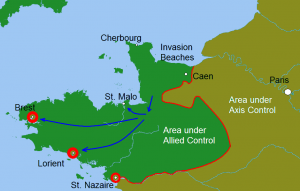
Fortress Lorient was not Lorient only, but also Groix Island, Etel River, the coast between Lorient and Port Navalo, Quiberon peninsula, Belle-Ile island, and had connection with the Saint Nazaire pocket.
So finally a big area to defend with lots of artillery, bunkers and trenches around the main part of Lorient.
To get a better view on the fighting during that time, we jump in after the D-Day to August 9th ,1944. The 4th US Armored Division reached the large-scale German defense area around Lorient, which was surrounded as an important submarine base by a ring of anti-aircraft guns and artillery. In Saint-Gilles fierce fighting broke out around a bridge, which was one of the few accesses to Lorient.
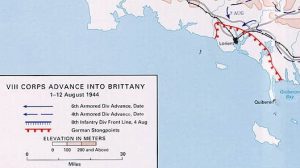
A volunteer Belarussian cavalry brigade had been stationed by the Germans in defense of the American advance in this place. After a short battle, the streets were covered in blood in the rain of the wounded or dead horses and soldiers. Further towards the village core, Belorussians had positioned themselves on the houses and in turn began firing at the invading US tanks.
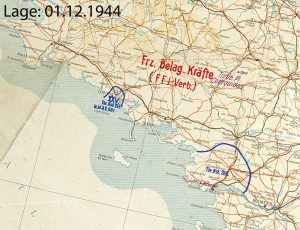
The tanks and other vehicles succeeded after some time the breakthrough to the bridge and its crossing. At nightfall, the Allies succeeded in positioning artillery at Caudan, about three kilometers north of Lorient. After brief bombardment of the opposing positions in Lorient, the Americans gave the Germans an ultimatum to the task, which was rejected. Since a further procedure would have been possible only with significantly increased artillery, the division leadership decided a partial retreat to the area of Vannes, about 60 kilometers southeast of Lorient. Only a smaller siege group was left behind.
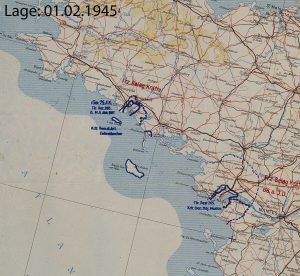
Task Force B of the 6th US Armored Division advanced 180 miles from Brest to Vannes on 14 August to replace the units of the 4th US Armored Division north and east of the city. On the way there they encountered no German resistance. Around noon, a reserve command advanced to Lorient to support the remaining group of the 4th US Armored Division. On August 15, the entire 6th US Armored Division arrived at Lorient. The front line enclosed the fortress Lorient and the Quiberon peninsula in the east as well as patrols from Redon in the east to the area to the Daoulas peninsula in the west.
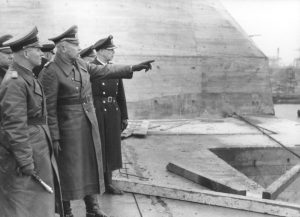
After Vannes was taken and the wider area was controlled by the French resistance, the 6th US Armored Division focused on the area around Lorient. The city itself was too heavily fortified to have a promising attack there. The German defenders, who are from parts of the XXV. Army Corps under the Commander-in-Chief for Brittany, General Wilhelm Fahrmbacher, as well as remnants of the 265th Infantry Division under Lieutenant General Hans Junck, who was in the fortress Saint-Nazaire, and Rear Admiral Otto Kähler, since February 1944 Commander of the Naval Defense of Brittany [NB Kähler, however, had become a prisoner of war on September 18, 1944 in Brest], passed, had in return no chance of counterattacking, and was also bound by Hitler’s order to keep the port cities to the last.
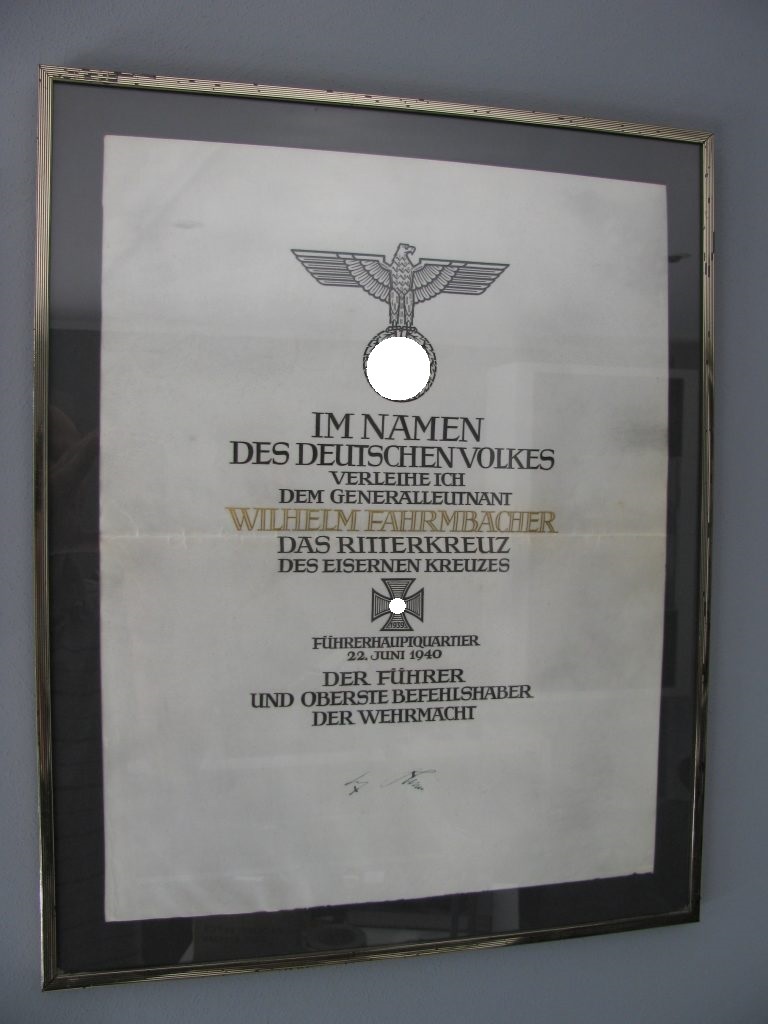
So both sides confined themselves to intensive patrols and artillery fire. The Americans had set up twelve observation posts around Lorient, from which reconnaissance units were sent to scout the German artillery positions. In addition, work began on mining the entire front line with booby traps. In some cases German patrols could be captured. But also Americans came during a small skirmish between reconnaissance patrols in German captivity.
The 6th US Armored Division was replaced on September 10 by the 94th US Infantry Division, which continued the siege, and moved east to the 3rd US Army. On 17 November, a brief ceasefire was agreed for the purpose of mutual exchange of prisoners. General Wilhelm Fahrmbacher capitulated on May 10, 1945,
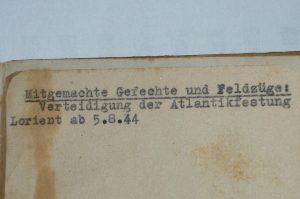
Both the Lorient and St.Nazaire pockets contained about 53000 German troops at the time of surrender. The Lorient pocket alone had over 25000 German troops.
These forces surrendered to the US 66th Infantry Division with a number of attached French units.
—-
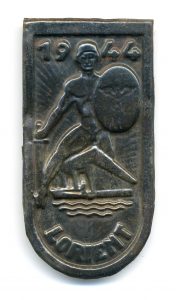
During the siege of Lorient the idea to make a remberence shield was born by some of the officers. The artistic design of the shield goes back to the head of the shipbuilding workshops of the submarine base “Marine Baurat” K. Fehrenberg. They asked General Fahrmbacher (Wilhelm Fahrmbacher (19 September 1888 – 27 April 1970) was a General in the Wehrmacht of Nazi Germany during World War II who commanded several corps. He was a recipient of the Knight’s Cross of the Iron Cross. Upon Germany’s surrender in 1945, General Fahrmbacher was interned in France until 1950.
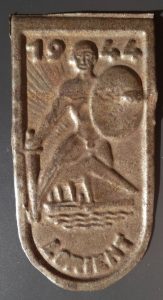
After his release he served as a military advisor in Egypt) and he approved the idea. With little corrections (a German eagle with a swastika on the soldiers shield) the shield was approved and the production began by using different materials due to the supply problems during the siege of Lorient.
The final shield itself shows in its upper end the year 1944 as well as on the lower side the lettering LORIENT. In the center, a naked Wehrmacht soldier was stylized with a steel helmet attached, holding a sword in his right hand and a shield (symbol of defense) in his left hand.
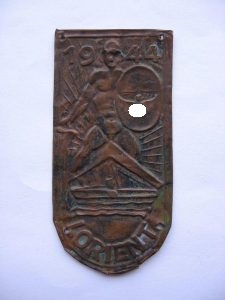
It is not exactly known if all Lorient shields have the Wehrmacht eagle on the soldiers shield, there are information about some shields with a Luftwaffen eagle on the soldiers shield (not proven until today). The unusual idea of representing a naked soldier presumably goes back to the idea of the creator, who wanted to use this symbolism to vividly portray „bare survival“. Also the evidence for this theory is missing. Behind the symbol of the soldier were represented the rays of the rising sun, which are regarded as a symbol of hope.
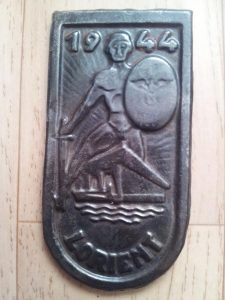
Finally, under the soldier a submarine is shown, which can be seen in front of a submarine bunker (on the Keroman Island) on waves in ride. Since it was not possible to supply the garrison on land, from the air or to water, it was decided to use the existing sheet metal stocks, u. a. from scrap, to resort. For the production one used copper, brass, aluminum and even steel. Higher officers received a chromed version of copper. Of course, the use of different metals also resulted in different colors. Through the use of several „punching presses“ and templates, the appearance of the sign differed significantly from machine to machine, so that there was no question of a uniform pattern embossing.
Accurate and reliable award numbers cannot be quantified. It is assumed that after all sheet metal stocks were used up in November 1944, about 10,000 – 12,000 shields were pressed. These were then issued at Christmas 1944 to deserving soldiers of the occupation. Thus, about every second garrison received the Lorient shield.







The Lorient shield is not a combat badge of the Wehrmacht like the Cholm shield, as neither its foundation nor the ceremony were officially. The shield was therefore regarded only as a „traditional badge“. With the entry in the “Soldbuch” also no claim to official acceptance of the shield by the Federal Ministry of the Interior. Therefore, this shield has not been included in the Law on Titles, Orders and Decorations of 26 July 1957.
Original Lorient Shields










After all these good information’s from collector friends, books, archives and databases I come to the following conclusion about Lorient shields.
There are some originals out there, but they are very hard to find. If it is true and they made 12.000 of them, what happened to the soldiers of Lorient during the surrender. Most of their personal things were taken by the allied soldiers as a souvenir. Maybe a few got their badges home from their POW time. I you look on the originals, you see them made of different materials. Some shields with prongs, some shields with holes to sew it to the uniform and some shields without anything of that. Originals are not made with a lot of details and they are not solid. You can always see that they were “pressed” in a certain way. Some have a fabric backing, but in my opinion that was made so you cannot see the backside and buy it as an original shield from the time period. In this high price area you have to be sure that you buy an original. Better to spend more money on it and buy at a dealer with a “give back guarantee”. Even if you buy directly from the family, there is no proof that the vet didn`t buy it in the early 50`s or 60`s. To be really sure you should use one of the bigger forums like GCA or WAF with all the experts there. They will know it for sure.
Copys of Lorient Shields













Big “thank you” to all collectors who helped me bring this information to you. There are Pascal, Patrick, Luc, Christian, Uwe, Holger, Jens and some guys who like to stay in the shadow.
Subscribe for more and get an email every time a new article goes online !
Best
Sascha
Copyright 2018 : Alle Rechte bei dem Verfasser Sascha Ulderup / All rights with the author Sascha Ulderup
Der Start!
Aktueller Blogstart am 24.09.2017 !